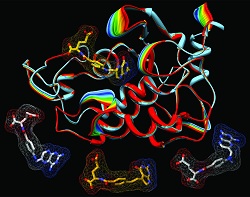 |
| Model of the human folate receptor with antifolate drugs used in chemotherapy--Courtesy of IU |
Researchers at Indiana University in Bloomington have discovered a way to deliver tried-and-true cancer drugs called antifolates more effectively by designing them to target specific receptors that populate cancer cells, leaving healthy cells alone and dispensing with many of their side effects.
Antifolate drugs interfere with molecules that contribute to cell growth, and although they have been used for 60 years, according to a report from the university, getting these drugs to be selective against cancer cells without harming healthy cells has been a problem. To overcome this obstacle, the IU researchers gave the drugs a different route by which to enter cells, using folate receptors that were prevalent exclusively on the cancer cells. They published their findings in the Proceedings of the National Academy of Sciences.
To fully understand the properties of the folate receptor proteins, the IU team used detailed crystallography and advanced robotics to create a "molecular snapshot" of the receptor, which allowed the researchers to create complementary drugs that acted like keys opening a lock. And cells without those receptors would be left alone.
The new delivery method has the potential to help treat ovarian cancer, which is normally resistant to treatment, as well as inflammatory diseases such as rheumatoid arthritis, Crohn's disease and psoriasis, according to the report.
"The goal is to hit those cells that are causative of disease but not hit the normal cells," said lead researcher Charles Dann III. "For decades, antifolates were all we had for treating certain cancers. Antifolates are great, but we think they can be made better by targeting them to specific cells."
So far, the team has been able to bind the drugs to the folate receptors, but they are currently working on a way to help release the drugs into the cell from there. The National Institutes of Health contributed funding for the research.
- here's the IU report
- get the PNAS abstract